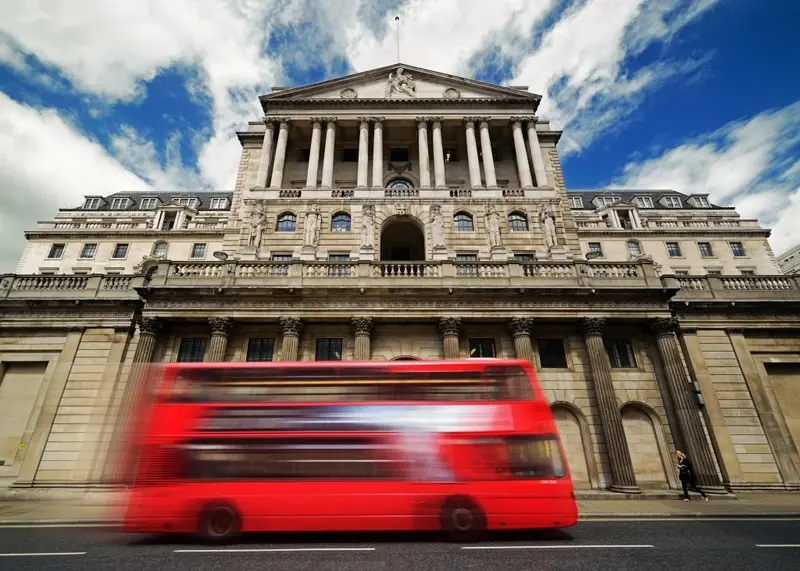
Stocks in London were mostly higher at midday Thursday, as the Bank of England followed the US Federal Reserve’s footsteps and decided against a hike.
Unlike the Fed, the BoE’s decision and accompanying statement were interpreted as dovish, putting pressure on sterling. Sterling was quoted at $1.2257 shortly after the decision, down versus $1.2295 just beforehand and, lower than $1.2396 at the London equities close on Wednesday.
The BoE maintained bank rate at 5.25%, a more than 15-year high, in what was somewhat of a surprise move. According to FXStreet cited consensus, a 25 basis point hike was expected, though a tamer UK inflation reading earlier this week meant some investors dialled back their rate hike bets.
It was a split outcome, with five Monetary Policy Committee members, Governor Andrew Bailey included, favouring the hold. Four would have preferred rates to remain unchanged, they were Jon Cunliffe, Megan Greene, Jonathan Haskel and Catherine Mann.
The FTSE 100 index was up 3.57 points at 7,735.22 heading into Thursday afternoon. The FTSE 250 was climbed 48.88 points, 0.3%, at 18,761.25, the AIM All-Share was down 4.99 points, 0.7%, at 741.71. All the measures bounced off sessions lows in the wake of the BoE decision.
The Cboe UK 100 was down 0.1% at 770.30, the Cboe UK 250 was up 0.3% at 16,391.71, and the Cboe Small Companies was up 0.5% at 13,517.22.
In European equities on Thursday, the CAC 40 in Paris was down 1.5%, while the DAX 40 in Frankfurt was down 1.1%.
Wednesday’s UK consumer price index data changed the face of the meeting. Annually, consumer prices rose by 6.7% in August, easing from a 6.8% rise in July, the data showed. August’s reading undershot market forecasts, as cited by FXStreet, which had predicted the inflation rate to heat up to 7.1%.
The annual core inflation rate - which excludes energy, food, alcohol, and tobacco - cooled to 6.2% in August, from July’s reading of 6.9%. August’s reading had been expected to come in at 6.8%.
The Bank of England said: ‘Five members judged that maintaining bank rate at 5.25% was warranted at this meeting. There were signs that the labour market was loosening. The recent acceleration in the average weekly earnings was noteworthy but was not apparent in other measures of wages. Although it was important not to put too much weight on a single data point, headline and services CPI inflation had fallen back and were lower than had been expected.
‘For one member, however, the risks of overtightening policy had continued to build, increasing the likelihood of output losses and volatility that would require sharper reversals of policy. Lags in the effects of monetary policy meant that sizeable impacts from past rate increases were still to come through.’
Those that favoured a hike noted that ‘there was evidence of more persistent inflationary pressures’.
Investors are also dissecting the latest communications from the US Fed.
The Fed decided to hold the federal funds rate between 5.25-5.50%, a 22-year-high. Despite pausing rates, the accompanying rhetoric was hawkish, with Fed Chair Jerome Powell refusing to rule out further interest rate rises.
Projections released in the Fed’s dot-plot showed the likelihood of one more increase this year, then two reductions in 2024, two fewer than were indicated during the last update in June. Powell said going into 2024, ‘the time will come at some point, and I’m not saying when,’ to cut interest rates.
Members of the Federal Open Market Committee have revised up their economic growth expectations for this year, with gross domestic product now expected to rise by 2.1%. That was more than double the June estimate, supporting hopes that the world’s largest economy is not heading into recession. The 2024 GDP outlook was lifted to 1.5%, from 1.1%.
Elsewhere in the central banking space, German Bundesbank President Joachim Nagel said that inflation remains too high in the eurozone, but remained uncommitted over whether he would back further European Central Bank interest rate increases.
‘Is that now it for key interest rate hikes? Have we reached the plateau? That can not yet be clearly foreseen,’ Nagel said Thursday in a speech to a banking group in Frankfurt.
Last week, the ECB Governing Council, of which Nagel is a member, raised the key interest rate at which banks can borrow money from the ECB by a further 0.25 percentage points to 4.50%.
The ECB Governing Council also raised the interest rate paid on deposits kept with the central bank to 4.0%, the highest level since the monetary union was established in 1999.
Analysts at Capital Economics commented: ‘Despite all the talk of ’higher for longer’, we believe that the global monetary policy tightening cycle is drawing to a close. In Q4, any final rate hikes in advanced economies will coincide with a number of cuts in emerging markets. And as we head into 2024, the loosening cycle will take hold. By this time next year, we anticipate that 21 out of the world’s 30 major central banks will be cutting interest rates.’
The euro traded at $1.0654, down from $1.0718. Against the yen, the dollar was quoted at JP¥147.84, up versus JP¥147.64.
Over in London, athleisure retailer JD Sports led the way in the FTSE 100, rising 6.7%.
It said pretax profit in the 26 weeks to July 29 surged 26% to £375.2 million from £298.3 million a year earlier. Revenue rose 8.3% to £4.78 billion from £4.42 billion.
JD Sports doubled its interim dividend to 0.30 pence per share from 0.15p.
JD Sports noted it returned to pre-pandemic levels of dividend cover, meaning the amount of profit that goes towards payouts.
The company explained: ‘During the pandemic, the group took a cautious approach with regards to dividend pay-outs so as to ensure that that cash reserves were maintained. As a consequence, in the aftermath of the pandemic, there was a disconnect between company earnings and dividend pay-outs.
‘The board recognises that JD is a very cash generative business and is committed to further enhancing returns to shareholders whilst ensuring that dividend pay-outs sit alongside other near-term cash outlays such as the minority buyouts of ISRG and MIG, the impending Courir acquisition and then, further out, future costs associated with any potential acquisition of the non-controlling interest in North America.’
Next added 3.5%, as it increased profit and sales guidance for its full year. It now expects full price sales in the second half to see 2.0% annual growth, compared to its previous guidance of 0.5%. This would take full-year growth to 2.6%.
It also raised full-year guidance for pretax profit to £875 million from £845 million previously, which would be up 0.5% from the prior year. Sales in the six months to July rose 5.4% year-on-year to £2.64 billion from £2.50 billion, as pretax profit rose 4.8% to £419.8 million from £400.6 million.
Marks & Spencer rose 1.9% in a positive read across, after decent reports from other large-cap retailers.
Among the FTSE 250, SSP declined 6.7%.
The travel food and beverage outlet operator said trading momentum was strong, and expects an improved annual performance. However, the Upper Crust owner noted some foreign exchange headwinds, given the recent strength of sterling.
It also predicted earnings per share, on an underlying pre-IFRS 16 basis, will be towards the lower end of a previously guided 7.0 pence to 7.5p range.
Elsewhere in London, DFS Furniture added 7.3%. It said it continued to win market share in a ‘very tough market’ during its financial year, which ended on June 25.
The furniture retailer said revenue from continuing operations fell 5.2% year-on-year to £1.09 billion from £1.15 billion, and pretax profit slumped 49% to £29.7 million from £58.5 million.
Underlying pretax profit before brand amortisation was £30.6 million, which was in line with its interim guidance, but down roughly half year-on-year from £60.3 million.
It expects underlying profit before tax and brand amortisation to improve in the low single digits in financial 2024, to a £30 to £35 million range.
It recommended a final dividend of 3.0p, down from 3.7p, bringing the annual total to 4.5p, down from 7.4p in the previous year.
Chief Executive Tim Stacey said: ‘The group is operating in one of the toughest economic climates we have experienced. Whilst we are confident the upholstery market will recover, forecasting the specific timing and pace of the recovery is challenging.’
Gold was quoted at $1,925.15 an ounce early Thursday afternoon, lower than $1,945.43 on Wednesday. Brent oil was trading at $92.61 a barrel, lower than $94.40.
Still to come on Thursday is the latest US initial jobless claims reading at 1330 BST. There is a eurozone consumer confidence reading at 1500 BST.
Copyright 2023 Alliance News Ltd. All Rights Reserved.




